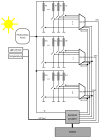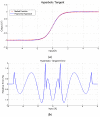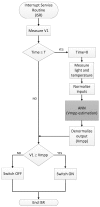A Compact Energy Harvesting System for Outdoor Wireless Sensor Nodes Based on a Low-Cost In Situ Photovoltaic Panel Characterization-Modelling Unit
- PMID: 28777330
- PMCID: PMC5579806
- DOI: 10.3390/s17081794
A Compact Energy Harvesting System for Outdoor Wireless Sensor Nodes Based on a Low-Cost In Situ Photovoltaic Panel Characterization-Modelling Unit
Abstract
This paper presents a low-cost high-efficiency solar energy harvesting system to power outdoor wireless sensor nodes. It is based on a Voltage Open Circuit (VOC) algorithm that estimates the open-circuit voltage by means of a multilayer perceptron neural network model trained using local experimental characterization data, which are acquired through a novel low cost characterization system incorporated into the deployed node. Both units-characterization and modelling-are controlled by the same low-cost microcontroller, providing a complete solution which can be understood as a virtual pilot cell, with identical characteristics to those of the specific small solar cell installed on the sensor node, that besides allows an easy adaptation to changes in the actual environmental conditions, panel aging, etc. Experimental comparison to a classical pilot panel based VOC algorithm show better efficiency under the same tested conditions.
Keywords: PV modelling; artificial neural network; cyber-physical systems; energy harvesting; maximum power point tracking; solar panel; wireless sensor network.
Conflict of interest statement
The authors declare no conflict of interest.
Figures


















References
-
- Han G., Dong Y., Guo H., Shu L., Wu D. Cross-layer optimized routing in wireless sensor networks with duty cycle and energy harvesting. Wirel. Commun. Mob. Comput. 2015;15:1957–1981. doi: 10.1002/wcm.2468. - DOI
-
- Cammarano A., Petrioli C., Spenza D. Online Energy Harvesting Prediction in Environmentally Powered Wireless Sensor Networks. IEEE Sens. J. 2016;16:6793–6804. doi: 10.1109/JSEN.2016.2587220. - DOI
-
- Mandourarakis I., Koutroulis E. Optimal design of a boost-type DC-DC converter for PV power-supplied wireless sensor networks; Proceedings of the 2015 IEEE International Conference on Industrial Technology (ICIT); Seville, Spain. 17–19 March 2015; pp. 1100–1105.
LinkOut - more resources
Full Text Sources
Other Literature Sources

